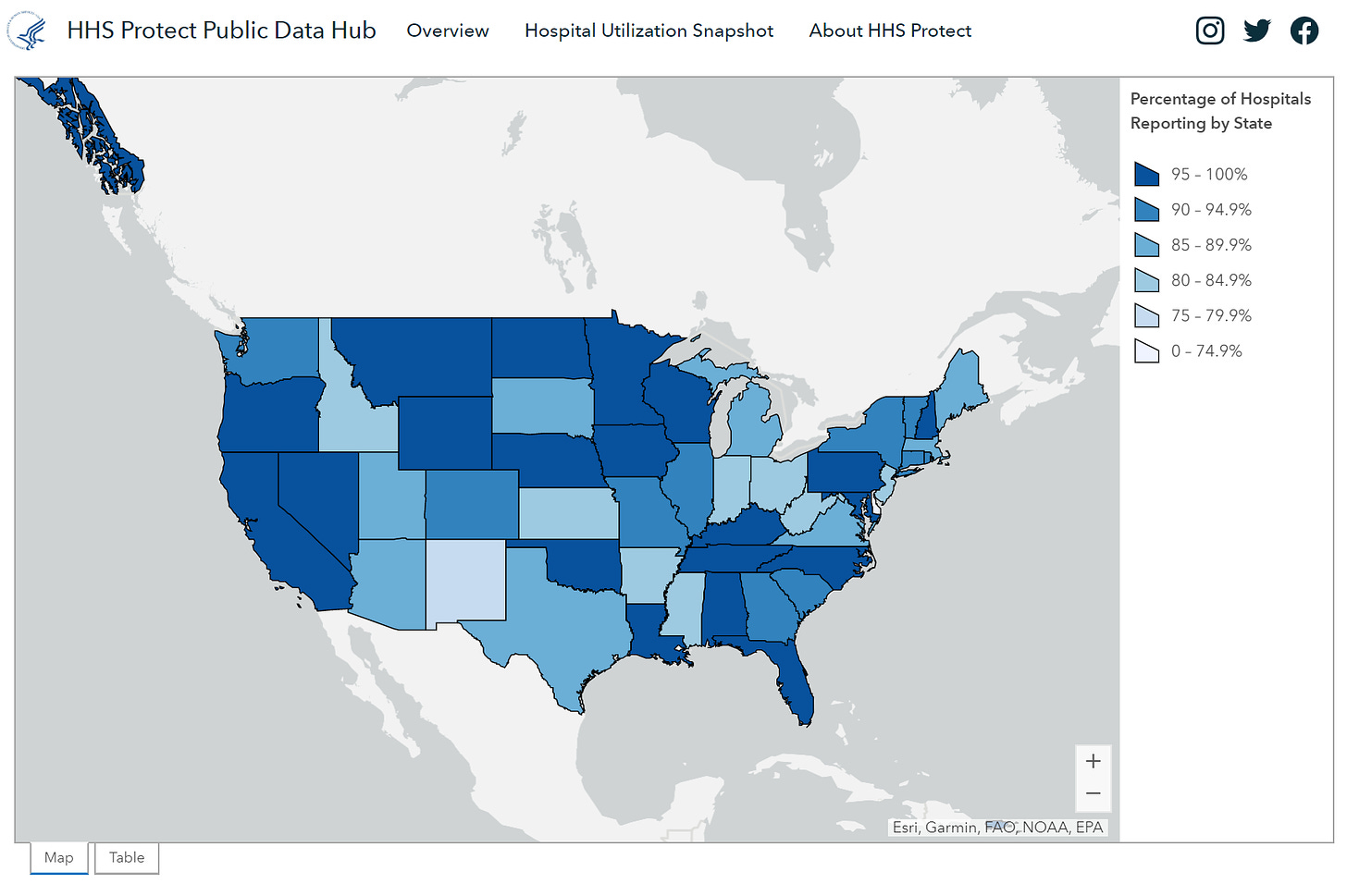On the HHS' blockchain project

A screenshot of HHS Protect that I took. This is, in part, powered by blockchain technology!
A little over two weeks ago the way that the US federal government reported COVID-19 data was suddenly changed. With the new changes hospitals would report directly data to the HHS instead of the CDC. The move was met with alarm and skepticism as lawmakers, pundits, and the public worried about politicization of critical data.
That is the context in which HHS Protect, the HHS’ new system for COVID-19 data, is being announced. It is also why the HHS has turned to blockchain technology to try and bolster trust in their data. To quote HHS Chief Information Officer José Arrieta:
At HHS Protect, every day, every data element we receive is hashed with a time-stamped record of the parcing and curation and sharing of that data element.
…
As a result of using blockchain technology with HHS Protect, the U.S. government can now, as Arrieta explained, “share with the general public how the results were generated because you have a record that is immutable.” Exactly how this would be accessed is unclear.
First let’s acknowledge how big of a deal this is. The HHS is using blockchain technology to underpin the single data system that is under the most scrutiny in the entire US federal government. That gives a new level of legitimacy to blockchain technology in general, and in healthcare specifically. Further, this happened at an incredible speed for the federal government and frankly it was bold for the project’s leader, who I assume is José Arrieta, to even try. Our industry is indebted to him for doing so!
It is a little unclear, but with multiple readings of the interview and HHS Protect’s FAQ I think that this system creates immutable records in three contexts:
-
Parse: when data is sent to the HHS a hash of the data is recorded on a blockchain
-
Curate: when someone accesses, changes, or manipulates data in HHS Protect a record of their action is recorded on a blockchain
-
Share: when data from HHS Protect is shared externally a hash of that data is recorded on a blockchain
The end result is that data stored on this blockchain creates a sort of audit trail that could be used by third parties to authenticate data on HHS Protect’s systems. They hope that this audit trail will give wary people assurances that data has not been improperly manipulated.
In this interview Arrieta confirmed that they are using a blockchain which is, in the words of the reporter, “similar to those supported by the Hyperledger organization and companies such as IBM as opposed to the bitcoin or ethereum blockchains.” I would think that if it was a Hyperledger project he would just say so, as they have done with HHS Accelerate, which is Arrieta’s other blockchain project. So we can rule out Hyperledger projects too, but that leaves me confused and really not sure what they are using.
These details are very important. I assume that more details are to come, along with the public facing functionality Arrieta referenced, but until then it is impossible to truly evaluate this solution without knowing what kind of technology they are using and who the nodes on their network are. The nodes of a network are integral to the integrity of the solution. For example if their nodes were the HHS, CDC, and the White House then these three parties could collude to change the ledger easily. I doubt any detractor’s concerns would be alleviated in that case.
In order to do what this solution intends to, which is inspire trust from deeply skeptical audiences, then the federal government truly cannot have control over the blockchain they use. If they do then it defeats the whole purpose of using a blockchain. There is a relatively straightforward technical solution here: the HHS could post their audit logs to a public blockchain like Bitcoin or Ethereum. These are extremely resistant to change, relatively cheap to use, anyone can access or verify them, and no one could reasonably claim the White House controls them.
Unfortunately there is very little chance of that happening soon. It was probably very difficult to make this happen as is, and using a public blockchain would likely be too much for the government to swallow right now. Moreover, Arrieta dismissed public blockchains by saying “The blockchain HHS uses is not the blockchain of the anarchists and disruptors.” That is the wrong way to think about public blockchains in general, but in most enterprise or government contexts, like that of HHS Accelerate, this attitude largely makes sense.
Ironically the reason I think the HHS should adopt a public blockchain is the same reason why “anarchists and disruptors” are attracted to them: no one controls public blockchains. The public can be absolutely sure that data put on a public blockchain has not been tampered with. Right now that kind of infrastructure is exactly what the HHS needs to garner more trust in their data, and for use cases where trust is paramount nothing beats public blockchains.
In closing I will offer a middle ground. The HHS could create a private blockchain network and ask a dozen or so hospitals and universities (e.g. Johns Hopkins) to run nodes. That would decentralize control out of the hands of the federal government and avoid public blockchains while still helping to establish trust with in their data.
Sign up for my newsletter
Every Sunday I send out a free blockchain and healthcare newsletter with top stories and ideas that you need to know about. Join leaders from the Mayo Clinic, Kaiser Permante, Optum, Amerisource Bergen, ConsenSys, Hashed Health, Pfizer, Goldman Sachs, and more by subscribing today.